Learn all you need in this Food Thermometer Buying Guide
Looking to buy a food thermometer for your kitchen, but not sure where to start? Food thermometers, also known as kitchen thermometers, meat thermometers, or instant-read thermometers, can quickly and accurately measure the temperature of your food, liquid, or oven and are essential for successful baking and cooking. There are several types of food thermometers, so which is the right one for you?
HowToBuyA will give you the information you need to buy the right food thermometer for you. We’ll also share some links to food thermometers that may suit your needs. Want to skip the How-To and get straight to our food thermometer suggestions? Click here for some HowToBuyA – Food Thermometer Suggestions.
Affiliate notice: When you buy through our links, we may earn a commission.
Sections of this Food Thermometer Buying Guide
- Why Use a Food Thermometer?
- What Are the Main Types of Food Thermometers?
- Quick-Check Food Thermometers with Digital Displays
- Leave-In Food Thermometers with Digital Displays
- More Details on Digital Food Thermometers
- Additional Features Found on Various Digital Display Models
- For Both Quick-Check and Leave-in Digital Thermometers
- Dial Display Thermometers
- Other Types of Food and Kitchen Thermometers
- Hybrid Food Thermometers
- Infrared Gun Food Thermometers
- Candy/Deep Fry Food Thermometers
- Oven Thermometers
- Fridge/Freezer Thermometers
- More About Food Thermometers
- Test Your New Food Thermometer!
- General Thoughts About Food Thermometers
- Food Thermometer Suggestions
- Quick-Check Digital Food-Thermometer Suggestions
- Leave-In Digital-Food-Thermometer Suggestions
- ThermoPro Leave-In Thermometers
- Non-ThermoPro Leave-In Thermometers
- Other Food- and Kitchen-Thermometer Suggestions
- Wrap Up
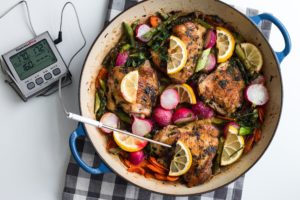
Why Use a Food Thermometer?
A food thermometer tells you exactly when a food or liquid is at the desired temperature. Use it to cook food to a safe internal temperature to avoid foodborne illness. With a food thermometer, you can:
- Cook steak to your desired doneness level each-and-every time.
- Know when to remove bread from the oven.
- Set your cooking oil to the correct temperature before frying.
- Monitor the temperature of meat inside ovens and smokers. Prevent heat loss from opening the oven or smoker to check the temperature.
- Confirm the internal temperature of your oven.
Cooking and baking often require precise temperatures. Use a food thermometer to remove guessing and be confident and consistent in the outcome of your dishes and baked goods.
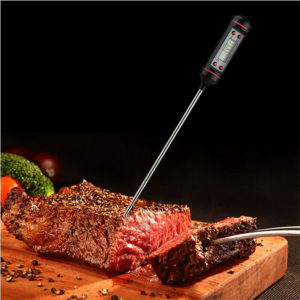
What Are the Main Types of Food Thermometers?
The two main types of food thermometers are quick-check food thermometers, used to quickly check the internal temperature of food near the end of the cooking process, and leave-in food thermometers, used to monitor the internal temperature of food throughout the cooking process.
Both types of thermometers can display the temperature with either an LCD digital display or a classic dial display. We will go over the digital-display models here and cover the dial-display models later in the guide.
Quick-Check Food Thermometers with Digital Displays
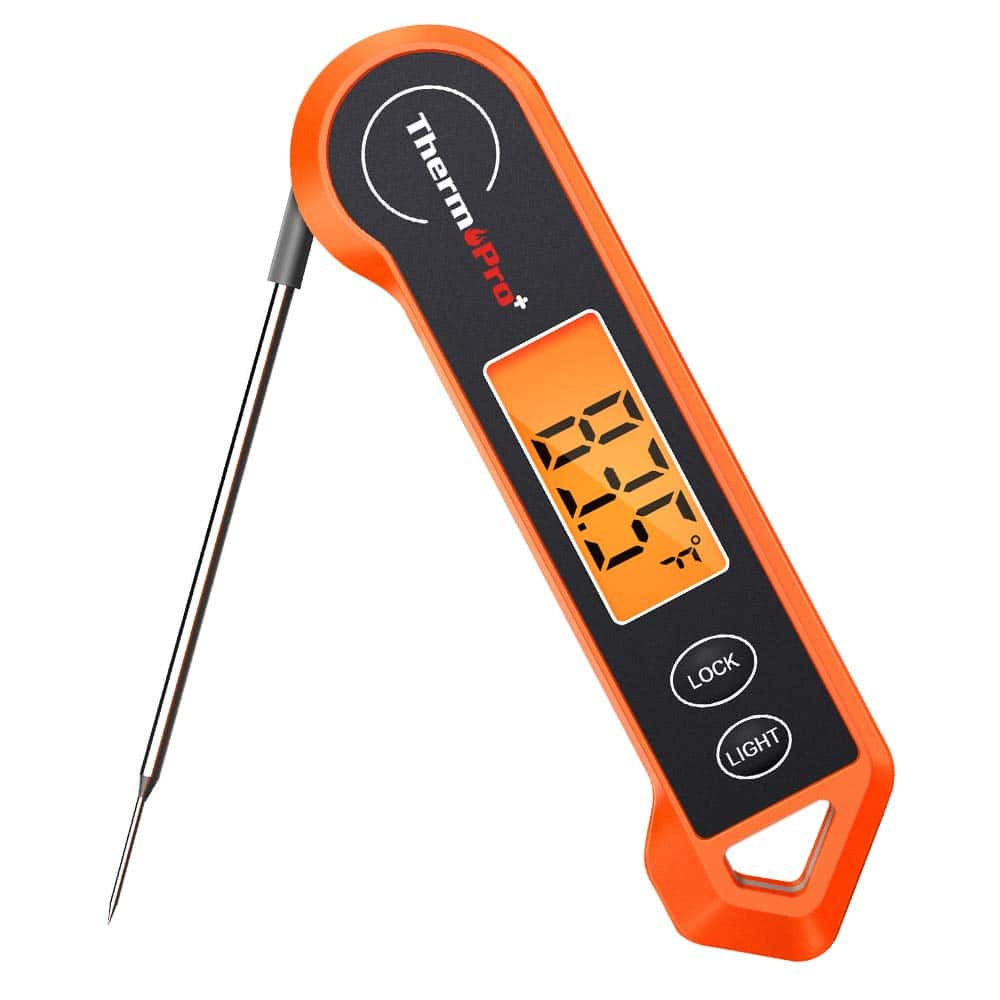
Digital quick-check food thermometers have a metallic probe that you insert into food to quickly read the temperature and then remove.
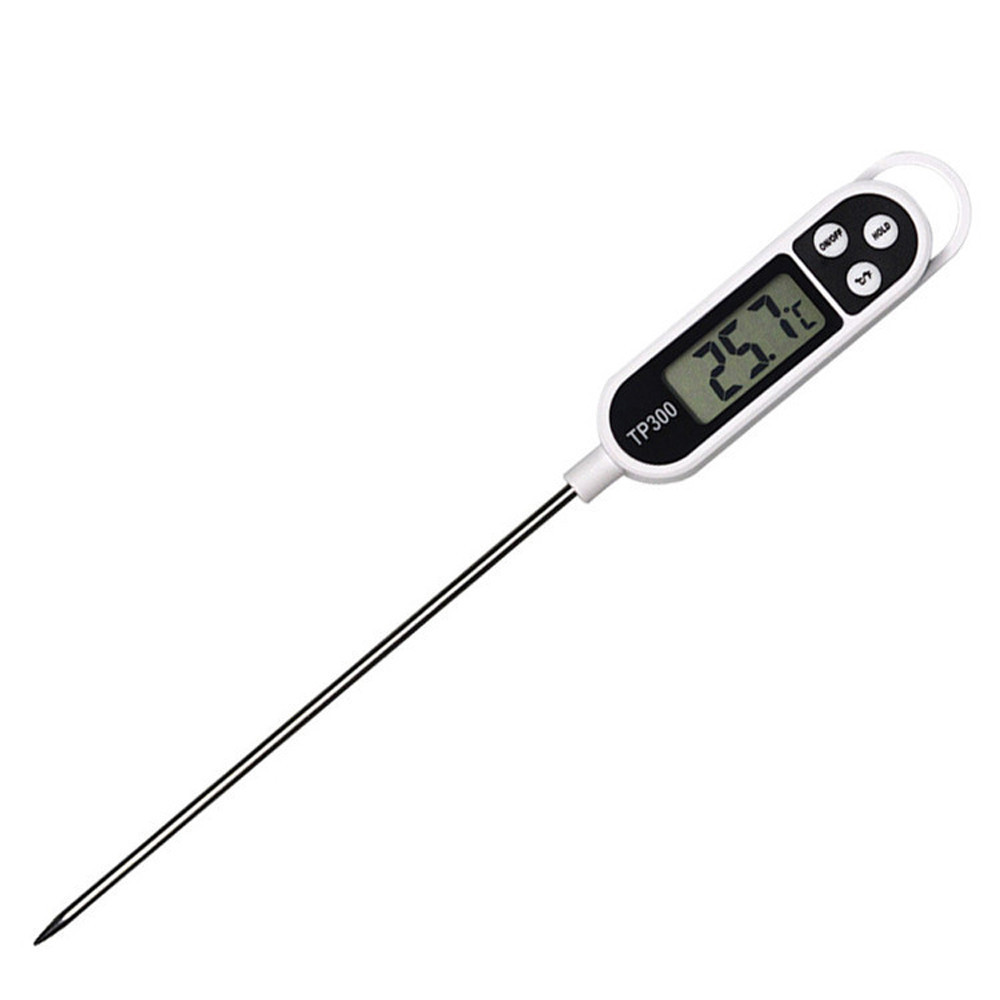
- They are not oven-safe and should not be left in food while cooking.
- The digital display is on the handle of the probe.
- The correct temperature displays almost immediately, usually within 15 seconds.
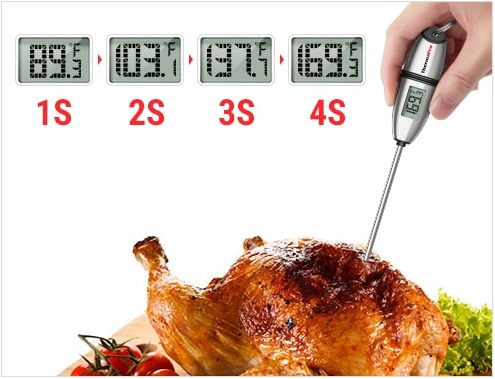 Called instant-read thermometers, the fastest display in about 2 to 5 seconds.
Called instant-read thermometers, the fastest display in about 2 to 5 seconds. - Use them to quickly check the temperature from several spots in the food.
- Various probe lengths are available, including probes that fold into the handle.
- See more features below.
Check out our quick-check food thermometers suggestions here.
Leave-In Food Thermometers with Digital Displays
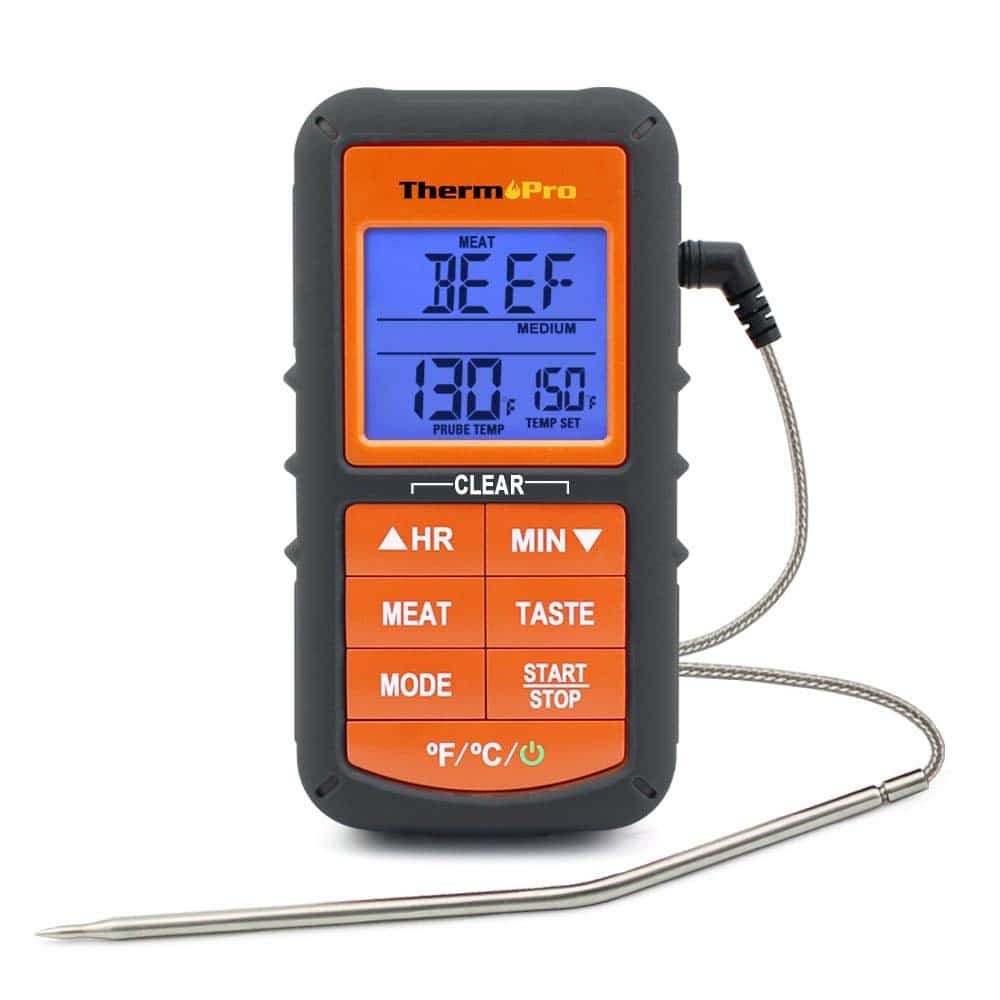
Digital leave-in food thermometers have a metallic probe that you insert into food, where it remains to monitor the food temperature during the cooking process.
- Their probes are oven-safe and designed to be left in food while cooking. Most models are safe for grills and smokers as well.
- The temperature displays on a separate unit connected to the probe with a heat-proof cable. On most units, the cable can withstand an internal oven temperature up to 716°F.
- The display unit is not oven-safe and must remain outside the oven or grill.
- If labeled instant-read, you can use them as quick-check thermometers by simply removing the probe after taking the temperature.
- See more features below.
Check out our leave-in food thermometers suggestions here.
More Details on Digital Food Thermometers
Additional features found on various digital models.
Digital Quick-Check Thermometer Features:
Auto Shutoff – Saves battery life.
Temperature Hold – Displays the temperature even after removing the probe from the food.
Back-lit display – Makes reading the display easy.
Fahrenheit/Celsius – Switch by pressing a key on the handle.
Built-in Magnet – Allows for easy storage on the side of your fridge or any metallic surface.
Digital Leave-In Thermometer Features: (Includes all of the above possible features.)
Multiple probes – Monitor temperatures in several pieces of meat or food at the same time or use one probe to monitor the ambient temperature (internal air temperature) of the oven. A clip is often provided to attach a second probe to the oven rack. 4-probe units usually have color-coded probes to distinguish between them easily.
Temperature Set – Enter your desired temperature, and the thermometer will alert you when the desired temperature is reached.
Preset Temperature – Choose a temperature based on the food type and doneness level.
High/Low Alarm – Available on models with at least two probes, use one probe to monitor the ambient (internal air) temperature of the oven, grill, or smoker. Set a maximum and minimum temperature, and the alarm will sound if the ambient temperature goes above or below this temperature range. It is especially useful for smokers and grills that may have fluctuating temperatures that need to be monitored carefully.
Timer – The alarm will sound when the count-down timer reaches zero. A count-up function is often available.
Wireless communication – 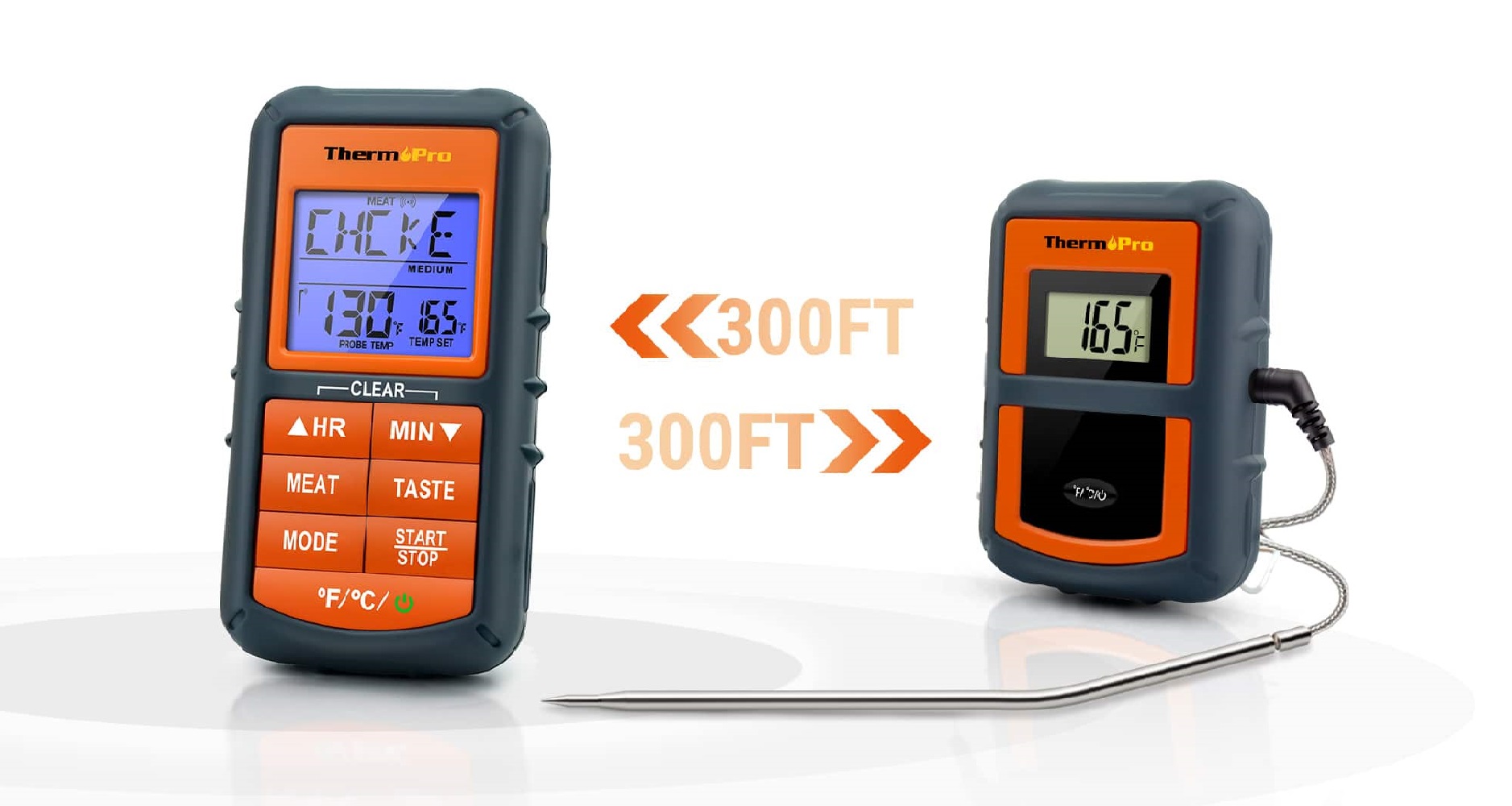 If you want to monitor the cooking process remotely, there are two methods for wirelessly receiving temperature data from the thermometer. In the first method, the display unit (a.k.a. the transmitter) uses radio frequency (RF) to send display information to a remote, secondary display unit (a.k.a. the receiver). In the second method, the display unit uses Bluetooth to send temperature data to your smartphone, which you access through an app you download onto your phone. Some thermometers have no display unit; the thermometer probe wirelessly connects to the smartphone app using Bluetooth. Wireless thermometers can transmit anywhere from 100ft to 1000ft, with RF units able to transmit further than Bluetooth units.
If you want to monitor the cooking process remotely, there are two methods for wirelessly receiving temperature data from the thermometer. In the first method, the display unit (a.k.a. the transmitter) uses radio frequency (RF) to send display information to a remote, secondary display unit (a.k.a. the receiver). In the second method, the display unit uses Bluetooth to send temperature data to your smartphone, which you access through an app you download onto your phone. Some thermometers have no display unit; the thermometer probe wirelessly connects to the smartphone app using Bluetooth. Wireless thermometers can transmit anywhere from 100ft to 1000ft, with RF units able to transmit further than Bluetooth units.
Rechargeable battery – Use the USB charging port on the unit to recharge the internal battery.
For both quick-check and leave-in digital thermometers:
![]() With some thermometers, the temperature reads at the tip of the probe. Use these on both thick or thin portions of food. With other models, the probes must be inserted to a specific length, usually at least 2 inches, to read the temperature accurately. These are difficult to use on thin portions of food but are suitable for thick portions like roasts and turkeys.
With some thermometers, the temperature reads at the tip of the probe. Use these on both thick or thin portions of food. With other models, the probes must be inserted to a specific length, usually at least 2 inches, to read the temperature accurately. These are difficult to use on thin portions of food but are suitable for thick portions like roasts and turkeys.
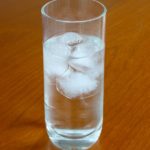 On certain models, the temperature can be calibrated. Insert the thermometer probe into some ice water to check the accuracy of the temperature. If calibration is needed, follow the instructions provided in the user manual to adjust the temperature reading so that it is accurate. Read more about calibration further below.
On certain models, the temperature can be calibrated. Insert the thermometer probe into some ice water to check the accuracy of the temperature. If calibration is needed, follow the instructions provided in the user manual to adjust the temperature reading so that it is accurate. Read more about calibration further below.
The temperature range varies from model to model. Thermometers with a large range, for example, 14°F to 572°F (-10°C to 300°C), can handle the more extreme temperatures required for activities like making candy or deep frying in hot oil.
Dial Display Thermometers
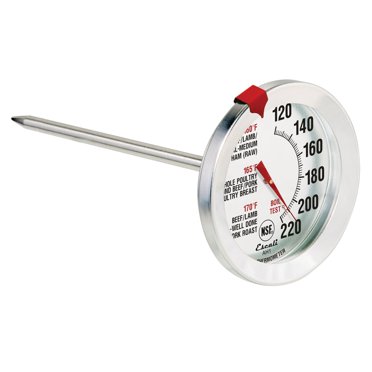
Dial thermometers have a metallic probe extending from a dial display.
- Both quick-check and leave-in models are available, and they may look similar or identical to each other. Quick-check versions are not oven-safe and should not be left in food while cooking. If the packaging doesn’t say oven-safe, you should assume that it is not safe to leave in the oven. Contact the seller to clarify.
- Some dial thermometers are considered instant-read, but it can take time for the dial to move to the correct temperature, 20 seconds or more.
- Some leave-in thermometers are not instant-read and can take over one minute to establish a temperature.
- Probes as long as 16 inches are available. Some probes must be inserted at least 2 inches or more in order to read the temperature accurately. If there is a spot on the probe, like a bump or indentation, this is the mark to show how far you must insert the probe.
- The temperature range varies widely on dial thermometers. Many leave-in dial thermometers have a range of 0°F to 220°F, which is suitable for monitoring the internal temperature of foods and their doneness level but is not capable of checking hot oil, which normally must be between 350°F and 375°F for frying foods.
- The minimum temperature on some dials can be as high as 50°F or 100°F. These thermometers cannot be tested for accuracy in an ice bath since they cannot reach the temperature of ice water (32°F). Keep reading to learn more about testing for accuracy.
- Some dial thermometers can be calibrated by turning a nut behind the dial.
- Many dial thermometers state that they are dishwasher safe, but a lot of negative reviews complain of moisture getting into the dial during dishwashing and fogging up the display. Your best bet is to rinse off only the probe with soap and water. If the dial is dirty, use a damp cloth to wipe it. If you insist on putting the thermometer in a dishwasher, wait until it has completely cooled before doing so.
Other Types of Food and Kitchen Thermometers
Hybrid Food Thermometers
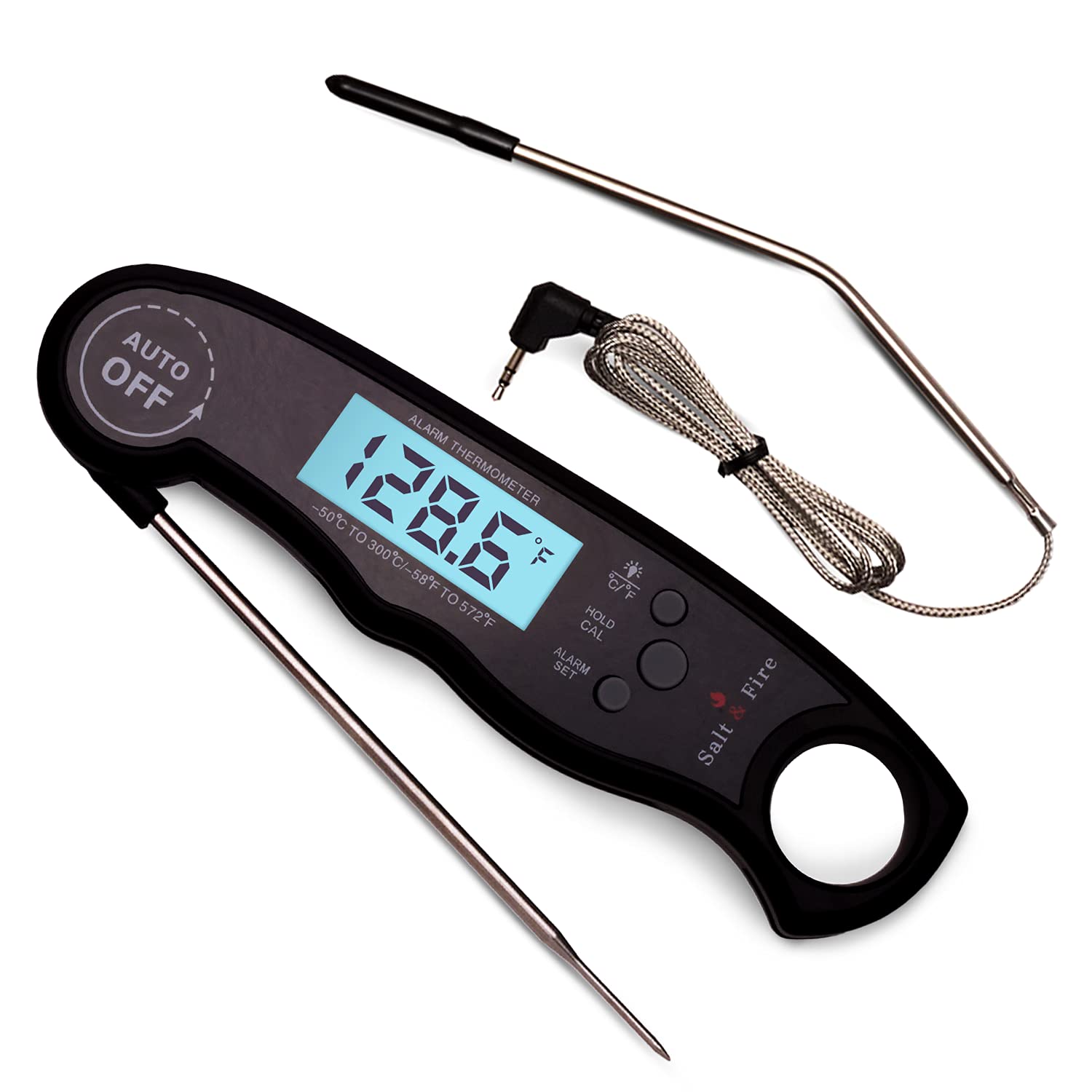
Hybrid Food thermometers are a combination of both quick-check and leave-in thermometers.
- They have two probes. The first probe extends from the handle. The second probe is oven-safe and connects to the handle by a heat-proof cable.
Infrared Gun Food Thermometers
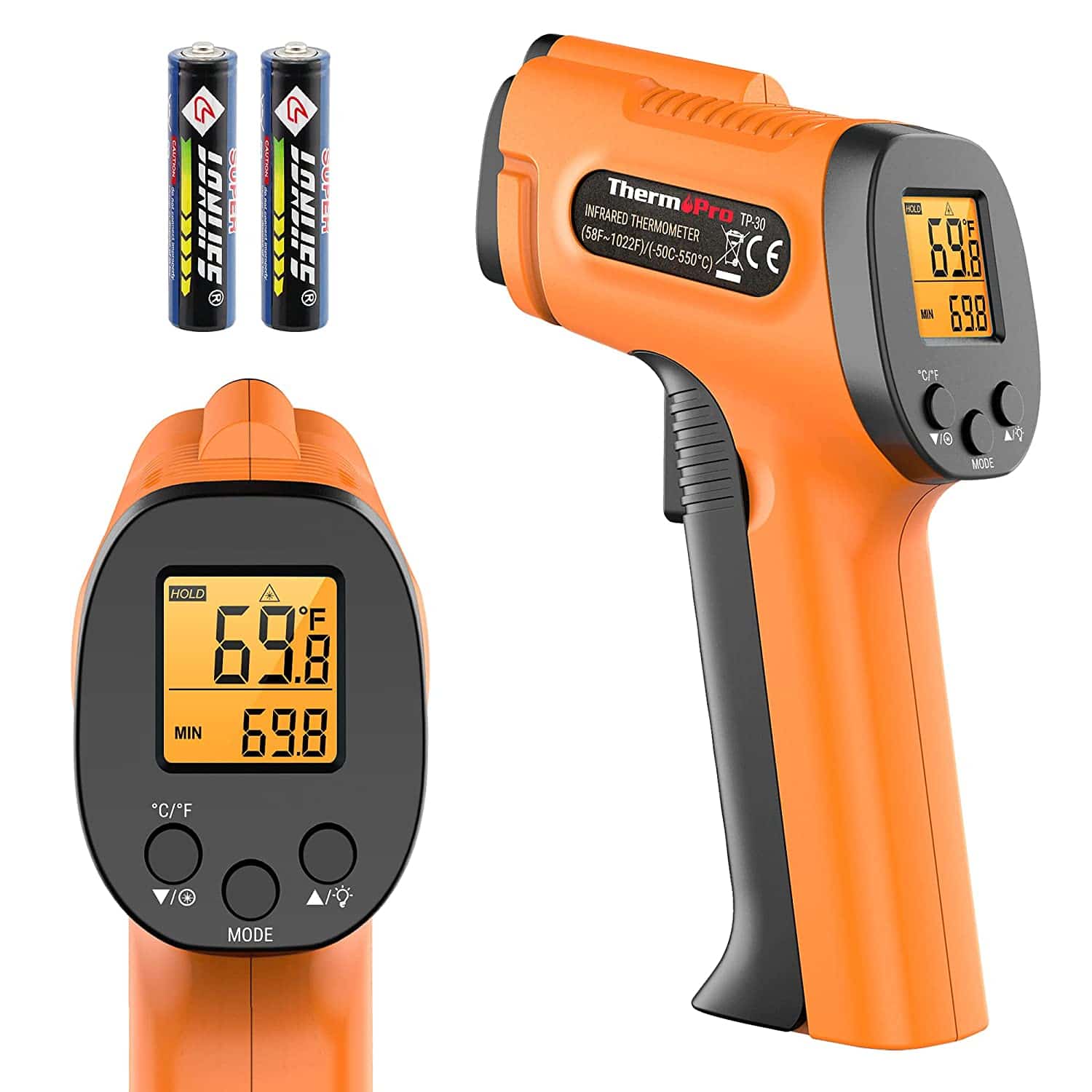
Infrared gun food thermometers use infrared technology to read the external surface temperature of an object.
- They can measure the temperature of liquids, like hot oil, the surface temperature of a pan, griddle, or pizza stone, or the internal temperature of an oven.
- They cannot be used to check if food has reached a safe internal temperature.
- They can be used for other purposes around the house, like checking the temperature of a bath or pool or the air temperature coming from an air conditioner or heater. They are not suitable for checking body temperature.
Candy/Deep Fry Food Thermometers
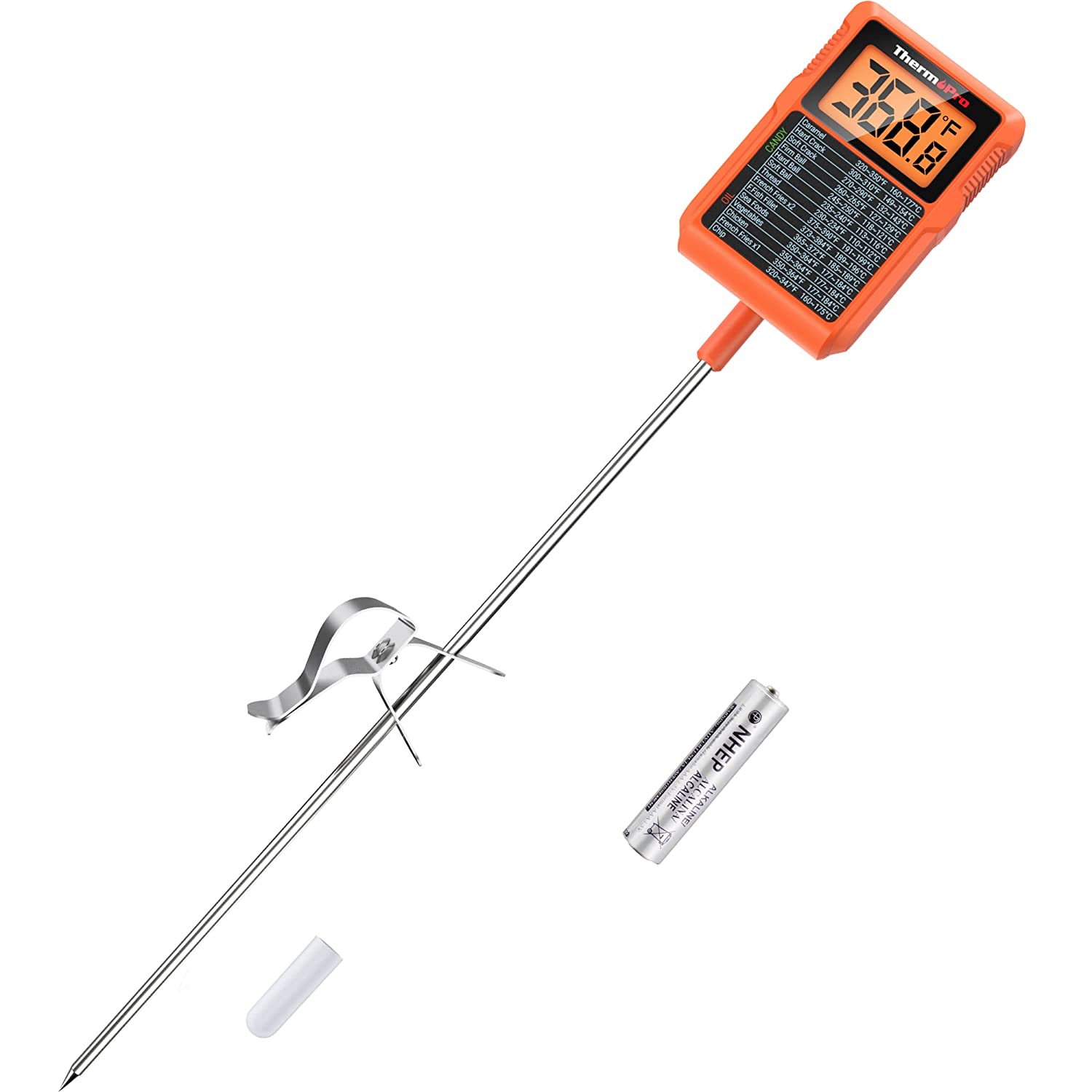
Candy/Deep fry food thermometers have a higher temperature range needed for making candy and frying in hot oil.
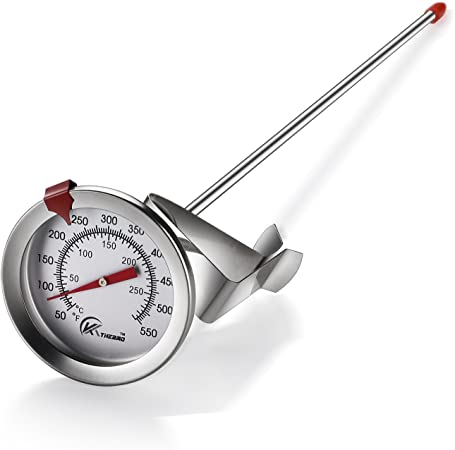
- Their probe is longer to reach into deep pans.
- They come with clips to attach to the side of pans.
- They usually have either a digital display or a dial display.
- Old fashion glass display thermometers are also still used for candy and hot oil; however, the chance that the glass might shatter into the candy or oil is a good reason to avoid this style.
- As mentioned above, infrared gun thermometers can also be used for candy and hot oil.
Oven Thermometers
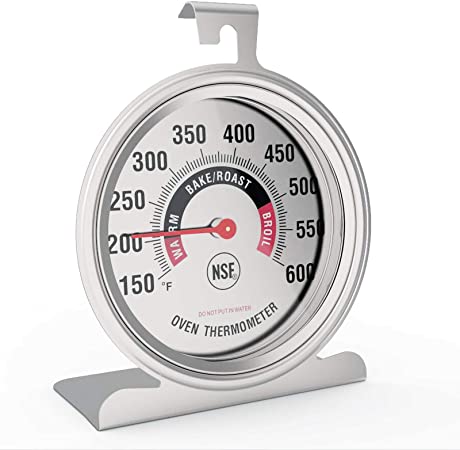
Oven thermometers are used to read the internal temperature of the oven, which can differ from what the oven’s dial is set at.
- Oven-safe, they remain in the oven, either hanging from or sitting on a rack.
- They most often have a dial display.
Fridge/Freezer Thermometers
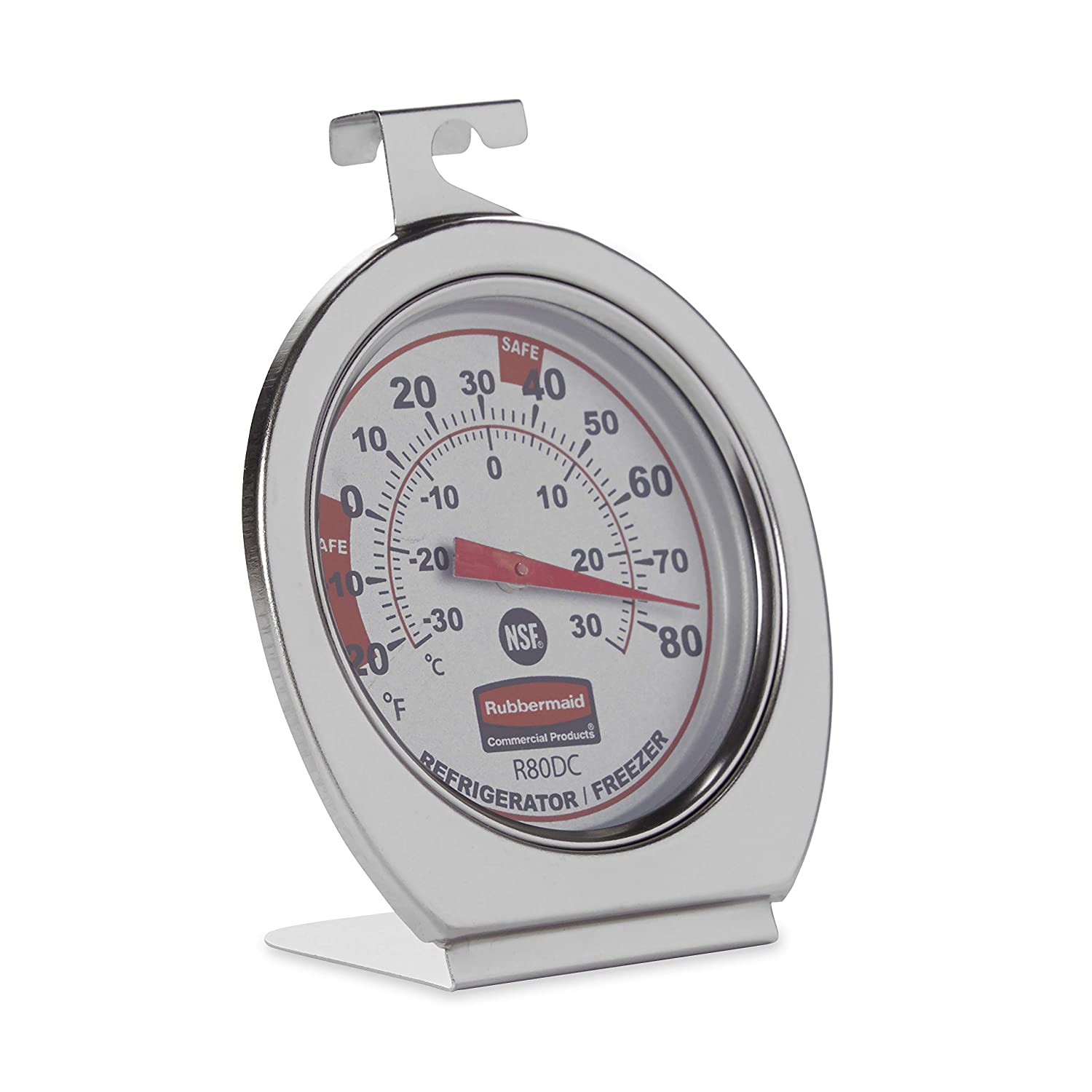
Fridge/Freezer thermometers are used to read the internal temperature of the refrigerator or freezer.
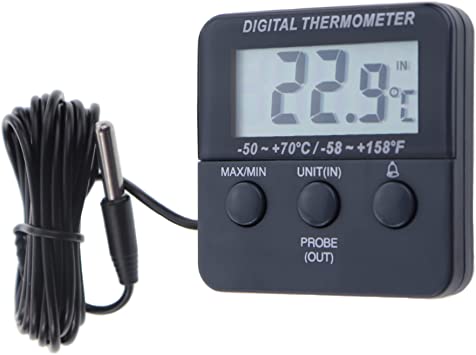
- Dial-display types are placed inside the refrigerator or freezer, either hanging from or sitting on a shelf.
- Digital-display units can be placed inside or outside the refrigerator or freezer, depending on the unit.
- Outside units have a temperature probe that is placed inside the refrigerator or freezer. The probe is connected to the display unit by a cable or wirelessly through radio frequency. These models have alarms that can alert you if the temperature goes too high or too low.
More About Food Thermometers.
Test your new food thermometer!
As always, HowToBuyA~ recommends that you thoroughly test your product within the return window. For Amazon, that is normally 30 days (As that may change at any time, please refer to Amazon’s return policy for exact information). For your thermometer, that means testing the accuracy and reliability of the temperature reading.
How to test your food thermometer for accuracy
A thermometer can be checked for accuracy by testing it either in ice water (32°F) or boiling water (around 212°F depending on altitude). Does your thermometer read 32°F when placed in an ice-water bath? Is the temperature the same reading over several attempts? If the answer is no, then your thermometer needs to be calibrated. If the answer is yes, great! Continue to test the thermometer over several days during the return window. Make sure the temperature remains reliable. Check other functions and features on the thermometer to make sure they are up to your standards.
How do you calibrate a food thermometer?
To calibrate your food thermometer, you must adjust the displayed temperature to match the correct temperature (either 32°F or 212°F). On a digital-display thermometer, you must press keys on the unit to raise or lower the displayed temperature to the correct temperature. On a dial-display thermometer, you must use a wrench to turn a nut behind the display until the pointer lines up with the correct temperature. Once adjusted, the thermometer should continue to display the corrected temperature. Because altitude can affect the boiling temperature of water, it is preferable to use an ice-water bath to calibrate food thermometers. Follow the instructions in your thermometer’s manual for exact instructions on how to calibrate your particular model.
Whether digital display or dial display, not all thermometers can be calibrated. If your thermometer is not reading the temperature accurately but has no calibration capability, your best solution is to return the product during the return window and try again. If the return window is closed, contact the seller. They should correct the problem if the thermometer is still under warranty and may do so even if it is not.
Live with inaccurate temperature readings with the help of math
Being able to calibrate your thermometer is a highly rated feature. If you cannot calibrate your thermometer and it loses accuracy over time, that could lead to some ruined dishes. Even if the thermometer is out of warranty, you might still be able to use it. When the temperature difference is consistent, you can use math to figure out the correct temperature.
Check the temperature in both ice water and boiling water. For example, if your thermometer consistently reads 52° in ice water and 232° in boiling water (depending on altitude), then the temperature is reading 20° degrees higher than it should be. Subtract 20° from the temperature reading when you use your thermometer to know the real temperature of the food.
Using the above example, if you get readings of 52°, 45°, and 56° in the ice water, then your readings are inconsistent. If your thermometer is reading 52° for ice water (20° degrees higher) and 252° in boiling water (40° degrees higher), then your readings are unreliable. In either case, you have no choice but to get rid of that thermometer and purchase a new one. Be sure to review your thermometer on Amazon or wherever you bought it so that other customers can know of your experience.
General thoughts about food thermometers.
Should you choose a quick-check or leave-in thermometer?
There are advantages to both quick-check and leave-in thermometers. Our best recommendation is to have one of both. Use the leave-in thermometer to monitor the temperature throughout the cooking process, but use the quick-check thermometer to confirm the temperature, especially towards the end of the cooking process. Having both helps you ensure that your food temperatures are accurate. If you must choose, quick-check thermometers are less expensive and have slightly better ratings than their leave-in counterparts. For digital-display thermometers, most quick-check versions can be calibrated for accuracy while leave-in models cannot.
Should you buy a folding-probe or straight-probe thermometer?
Many quick-check thermometers have a probe that folds in towards the handle for easy storage. These probes can be inserted into food at any angle up to 180 degrees from the handle. The connection point between the probe and the unit can be a weak point, however, and some reviews complain about thermometers breaking at that point. Avoid stressing, flexing, or repeatedly opening/closing the probe.
While not as compact as those with folding probes, thermometers with straight probes are solid units without any moving parts, so they may prove to be more durable and long-lasting. They often come with a plastic sheath or cap to protect the probe during storage. Their probes are often longer than folding probes, which can be useful for checking oil in a deep pot or reaching into a hot oven to take a quick temperature.
Other common complaints
One of the most common complaints about digital-display leave-in thermometers is that the probes become inaccurate or die. These probes and their cables are subjected to high heat for long periods at a time. On top of that, most leave-in thermometers cannot be calibrated if they become inaccurate. Make sure the model you like has a warranty that will replace probes if they stop working correctly. Check comments to see if the seller honors their warranty. Search whether there are replacement probes for sale and how much they cost before you buy.
Another complaint is that the distance that wireless thermometers actually transmit data is much less than what is advertised. If this feature is important for you, check comments to make sure that users are able to receive display data at the distances promised. As with any wireless technology, walls and other barriers may interfere with the signal.
Battery life
Using your digital leave-in thermometer to monitor your food’s temperature throughout the cooking process will, of course, use the battery’s power. Rechargeable batteries will save you from buying lots of new batteries. Another option is to only turn on the display every hour or half-hour while cooking to periodically check the temperature without opening the oven.
Dial-display thermometers are simple, comparatively inexpensive, and require no batteries. If you can find an accurate model, it can last you a lifetime.
Hot thermometer! Handle carefully!
When using leave-in thermometers, the cables, probes, and dial displays get extremely hot. Use oven gloves to remove the probes from the food. Allow the thermometer parts to cool down before you attempt to clean them. Follow any handling or cleaning instructions provided in the manual.
Take care not to attach the display unit of a leave-in thermometer to a hot surface, like the side of a grill or smoker. The plastic casing on the thermometer will melt.
A note about terminology
Many internet sites categorize quick-check thermometers as simply “instant-read thermometers” and leave-in thermometers as “meat thermometers.” With current thermometer technology, this labeling is confusing since both quick-check and leave-in thermometers have units that can read temperatures instantly (within 15 seconds). Likewise, both quick-check and leave-in thermometers are used on meat, and leave-in thermometers can be used for food and liquids other than just meat. We find categorizing by manner of use, i.e., quick-check or leave-in, to be the best way to distinguish these two groups of thermometers.
HowToBuyA – Food Thermometer Suggestions
Now that you have a good understanding of what kind of food thermometers are available, take a look at our suggestions for food thermometers. They are some of the best-reviewed food thermometers on Amazon. We have separated them for you by type: quick-check digital, leave-in digital, and other.
Affiliate notice: When you buy through our links, we may earn a commission.
Quick-check digital food thermometers
Below, you will find some of Amazon’s most popular quick-check food thermometers, with either straight probes or folding probes. ThermoPro thermometers are probably the most popular on Amazon, but the other thermometers here also receive good reviews. These thermometers all have the following features: calibration, backlit display, Fahrenheit or Celsius switch, temperature hold, auto-off, and a built-in magnet for storage. Click on the links to be taken to Amazon and learn more about each product.
Swipe or scroll right to see more quick-check food thermometers.
 |
 |
 |
 |
 |
 |
 |
 |
 |
|
|---|---|---|---|---|---|---|---|---|---|
| Brand | ThermoPro | Kizen | ThermoPro | ThermoPro | ThermoPro | ImSaferell | Alpha Grillers | Kuluner | Kizen |
| Model | TP15 | IP109 | TP03H | TP19 | TP18 | DT-68 | Vegena | None | None |
| Temp Range | -58°F to 572°F (-50°C to 300°C) | -58°F to 572°F (-50°C to 300°C) | -58°F to 572°F (-50°C to 300°C) | -58°F to 572°F (-50°C to 300°C) | 14°F to 572°F (-10°C to 300°C) | -58°F to 572°F (-50°C to 300°C) | -58°F to 572°F (-50°C to 300°C) | -58°F to 572°F (-50°C to 300°C) | -58°F to 572°F (-50°C to 300°C) |
| Read Time | 3-4 secs | 2-4 secs | 3-4 secs | 2-3 secs | 2-3 secs | 2-3 secs | 2-4 secs | 3 secs | 3 secs |
| Probe Length | 5.36″ | 5.25″ | 3.9″ | 4.25″ | 4.0″ | Unknown | 4.5″ | 4.6″ | 4.4″ |
| Folding Probe | No | No | Yes | Yes | Yes | Yes | Yes | Yes | Yes |
| More Info | Check Price | Check Price | Check Price | Check Price | Check Price | Check Price | Check Price | Check Price | Check Price |
Leave-in digital food thermometers
Next, we have our leave-in food thermometers. There are a lot of options to choose from, as you can see in our tables below. The ThermoPro brand has a full line of leave-in thermometers, which we have put into its own section below. One important note about these leave-in thermometers: none of them have a calibration function. If the readings become inaccurate, you will not be able to recalibrate the temperature.
ThermoPro Leave-in Thermometers
All of the following ThermoPro leave-in thermometers are instant read and the temperature reads from the tip of the thermometer. Their cables are 40 inches with stainless-steel mesh rated for 716°F.
Swipe or scroll right to see more leave-in food thermometers.
 |
 |
 |
 |
 |
 |
 |
 |
 |
 |
 |
 |
 |
 |
|
|---|---|---|---|---|---|---|---|---|---|---|---|---|---|---|
| Brand | ThermoPro | ThermoPro | ThermoPro | ThermoPro | ThermoPro | ThermoPro | ThermoPro | ThermoPro | ThermoPro | ThermoPro | ThermoPro | ThermoPro | ThermoPro | ThermoPro |
| Model | TP-16 | TP06S | TP-17 | TP-17H | TP-20 | TP-07S | TP-08B | TP-910 | TP-25 | TP-930 | TP27 | TP-28 | TP-826 | TP-829 |
| Temp Range | 32°F to 572°F (0°C to 300°C) | 16˚F to 482˚F (-9˚C to 250˚C) | 14˚F to 572˚F (-10˚C to 300˚C) | 14˚F to 572˚F (-10˚C to 300˚C) | 32°F to 572°F (0°C to 300°C) | 32°F to 572°F (0°C to 300°C) | 14˚F to 572˚F (-10˚C to 300˚C) | 14˚F to 572˚F (-10˚C to 300˚C) | 32°F to 572°F (0°C to 300°C) | 14˚F to 572˚F (-10˚C to 300˚C) | 14˚F to 572˚F (-10˚C to 300˚C) | 14˚F to 572˚F (-10˚C to 300˚C) | 14˚F to 572˚F (-10˚C to 300˚C) | 14˚F to 572˚F (-10˚C to 300˚C) |
| Num of Probes | 1 | 1 | 2 | 4 – Color Coded | 2 | 1 | 2 | 2 | 4 – Color Coded | 4 – Color Coded | 4 – Color Coded | 2 | 2 | 4 – Color Coded |
| Wireless Type1 & Distance | None | None | None | None | RF – 300ft | RF – 300ft | RF – 500ft | BT – 500ft | BT – 500ft | BT – 500ft | RF – 500ft | RF – 500ft | RF – 500ft | RF – 1000ft |
| Built-in Magnet | Yes | No | Yes | Yes | No | No | No | No | No | No | Yes | Yes | No/Yes2 | No/Yes2 |
| Backlit Display | No | Yes | Yes | Yes | Yes | Yes | Yes | Yes | Yes | Yes | Yes | Yes | Yes | Yes |
| Timer | Yes | Yes | Yes | No | Yes | Yes | Yes | Yes | Yes | Yes | No | Yes | Yes | Yes |
| Hgh/Low Alarm | No | No | Yes | Yes | Yes | No | Yes | Yes | Yes | Yes | Yes | Yes | Yes | Yes |
| Probe Length | 6.5″ | 6.5″ | 8.5″ | 8.5″ | 8.5″ | 6.5″ | 8.5″ | 8.5″ | 8.5″ | 8.0″ | 6.5″ | 6.5″ | 6.5″ | 6.5″ |
| Battery | 1 AAA | 2 AAA | 1 AAA | 1 AAA | 4 AAA | 4 AAA | 4 AAA | Lithium ion rechargeable | Lithium ion rechargeable | Lithium ion rechargeable | 4 AAA | 4 AAA | 4 AAA | 4 AAA |
| More Info | Check price | Check price | Check price | Check price | Check price | Check price | Check price | Check price | Check price | Check price | Check price | Check price | Check price | Check price |
1Wireless Type: RF= Radio Frequency, BT= Bluetooth
2The display unit does not have a magnet. The remote unit has a magnet.
Non-ThermoPro Leave-in Thermometers
These thermometers all have a timer and a backlit display, except for the Meater thermometer. The Meater thermometer has no display unit and connects directly with your smartphone through an app that you must download. Other thermometers here have a smartphone app in addition to a display unit. Like the ThermoPro models, none of these thermometers can be calibrated.
Swipe or scroll right to see more leave-in food thermometers.
 |
 |
 |
 |
 |
 |
 |
 |
 |
 |
|
|---|---|---|---|---|---|---|---|---|---|---|
| Brand | Meater | Soraken | Melophy | Taimasi | Enzoo | Vauno | Nextamz | Veken | Vauno | Guichon |
| Model | OSC-MT-MP01 | None | ME | FS-06 | None | EN2053-3 | EN2053 | None | EN2058-4 | YB918 |
| Temp Range | Up to 212°F internal / 527°F ambient | 32°F to 482°F | 32°F to 716°F | 32°F to 572°F (0°C to 300°C) | 32°F to 572°F (0°C to 300°C) | -4°F to 572°F (-20°C to 300°C) | -4°F to 572°F (-20°C to 300°C) | Unknown | -4°F to 572°F (-20°C to 300°C) | 14˚F to 572˚F (-10˚C to 300˚C) |
| Num of Probes | 1 | 4 – Color Coded | 6 – Color Coded | 4 – Color Coded | 4 – Color Coded | 3 | 2 | 4 – Color Coded | 4 – Color Coded | 4 – Color Coded |
| Probe Length | Unknown | Unknown | 6″ | 4.7″ | 4.7″ | 4.6″ | Unknown | 6″ | 6″ | Unknown |
| Cable Length | N/A | 47.2″ | 43″ | 43″ | 43″ | 40″ | Unknown | 49″ | Unknown | Unknown |
| Wireless Type1 & Distance | BT – 165ft | BT – 100ft | BT – 300ft | RF – 500ft | RF – 500ft | RF – 490ft | RF – 328ft | RF – 490ft | RF – 490ft | RF – 500ft |
| Connect to smartphone | Yes | Yes | Yes | No | No | No | No | No | No | No |
| Magnet | N/A | Yes | No | Yes | Yes | No | No | No | No | No |
| High/Low Alarm | N/A | Yes | Yes | Yes | Yes | Yes | Yes | Yes | No | Yes |
| Battery | 1 AAA | 2 AA | 2 AAA – not included | 4 AAA | 4 AAA | 4 AAA | 4 AAA | 4 AAA | 4 AAA | 4 AAA |
| More Info | Check price | Check price | Check price | Check price | Check price | Check price | Check price | Check price | Check price | Check price |
1Wireless Type: RF= Radio Frequency, BT= Bluetooth
Other food- & kitchen-thermometer suggestions
Finally, here is an assortment of dial display thermometers, oven thermometers, infrared gun thermometers, and refrigerator/freezer thermometers.
Wrap Up
Food thermometers are a great tool to have in the kitchen. We hope you have learned all you need to know to buy the best food thermometer for you! Let us know what kind of food thermometer you end up buying and why in the comments below.












